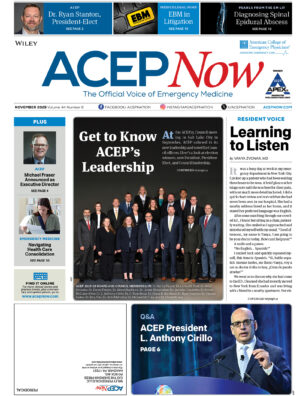Editor’s Note: Read Dr. Cedric Dark’s commentary on this EMRA + PolicyRx Health Policy Journal Club article.
Explore This Issue
ACEP Now: Vol 39 – No 08 – August 2020A “surprise medical bill” is a term used to describe bills charged to an insured person receiving care, inadvertently or intentionally, from an out-of-network (OON) physician. This arises when a patient receives care at an in-network (INN) facility but is treated by an OON physician. A significant amount of attention is being paid to surprise bills from the emergency department.
The amount patients may be charged can be astronomical. A recent article discussed the California approach, AB-72, which limits a patient’s cost sharing to INN levels for all nonemergency physician services at INN hospitals unless the patient provides written consent 24 hours in advance. Due to this change, physicians lost leverage in terms of negotiating contracts and thus formed conglomerates to regain bargaining power.
A recent qualitative study analyzed interviews with 28 stakeholders six to 12 months after implementation of the California law.1 Interviewees included representatives of advocacy organizations and executives of physician practice groups, hospitals, and health benefit companies.
The interviews revealed that worker, payer, and consumer advocates agreed it is important to protect patients from surprise medical bills; the law is working as planned. However, hospital-based physicians now face substantial lack of leverage in negotiations. They no longer have the ability to charge typical rates, and are instead getting paid the lower OON capped payment or 125 percent of Medicare reimbursement. Using the payer-reported local average contracted rate (defined as a commercial rate contracted by a health insurer for the same or similar service in the geographic region) as the OON payment standard has incentivized payers to cancel contracts with physicians who have existing contracts that exceed local averages. Payers thereby substantially lowered the average rate and subsequently decreased physician reimbursement.
In response, many physicians have consolidated to regain leverage. In turn, patients felt they lost options for care because they now had a smaller pool of physicians from which to choose.
The California approach applies to specialties that were accustomed to billing full OON charges. Specialists reported that AB-72 would cause long-term pay stagnation, make it harder to recruit physicians, and lead to a decrease in physicians willing to staff undesirable shifts. These changes could be problematic for safety-net hospitals that rely on high commercial payments to attract physicians to underserved areas.
In the final analysis, California now protects patients from surprise billing, but the approach alters negotiating leverage between payers and physicians. The California experience allowed insurers to lower payments to physicians, providing early insight into the tradeoffs of one of the possible solutions for surprise billing currently under discussion nationwide.
Dr. Woodington is an emergency medicine resident at Baylor College of Medicine.
Reference
- Duffy EL. Influence of out-of-network payment standards on insurer–provider bargaining: California’s experience. Am J Manag Care. 2019;25(8):e243-246.
Pages: 1 2 | Multi-Page





No Responses to “California’s Approach to Surprise Billing Disadvantaged Physicians”